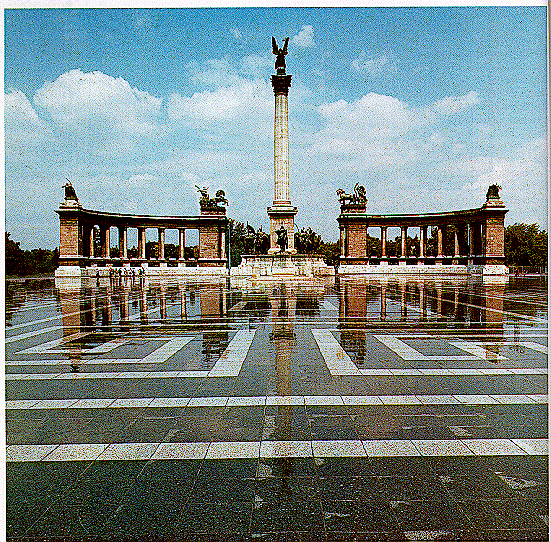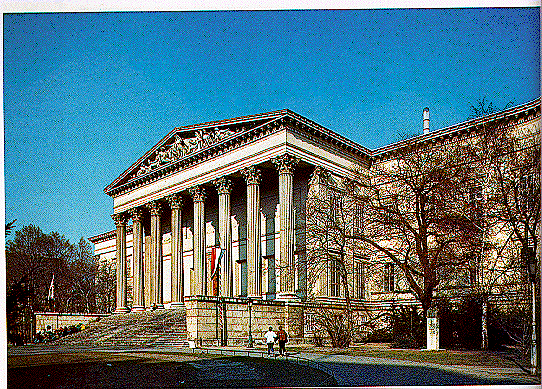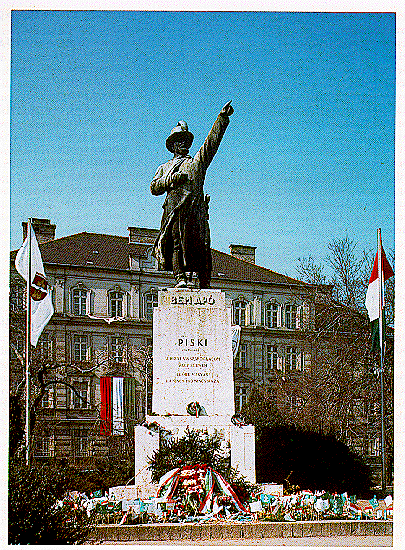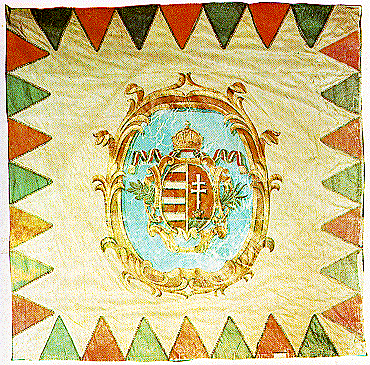A Thorough Look at Budapest Images
Andras Szeitz

The first Hungarian settlers arrived in Transylvania in 896 A.D. which, as part of the Carpathian Basin, was a large land sporadically inhabited by the remnants of Attila the Hun's people, the Avars. The pagan Hungarian tribes settled here, turned to the Christian faith and, led by the first Hungarian king Saint Stephen I , established the Hungarian state in 1000. After one thousand years, in 1896, Hungary celebrated the millennial anniversary of the formation of the state. The country had been preparing for this milestone event for years by making tremendous development of the country's infrastructure. They built new buildings, roads, railroad lines, industrial facilities everywhere in Hungary, and during this very prosperous era, the towns, large municipalities, etc. received a very characteristic and similar stylish architectural image all over the historic Hungary (dismembered in 1921 ). No exception was Budapest which also obtained its current appearance, i.e. the street networks, most of its neoclassical buildings, the first underground train in the continent, major railroad stations, many museums, national institutions, monuments during this time. Among them was the Millennial Memorial.
The Millennial Memorial was designed and built for the millennial anniversary of Hungary (1896) to commemorate the greatest figures of the Hungarian history. It hosts the equestrian statues of the seven Hungarian tribe leaders who came to Transylvania in 896, as well as 14 bronze sculptures of kings, liberation leaders and chancellors of the Hungary, but the monument also delivers a more global message about War, Peace, Work, Welfare, Knowledge and Glory.
The construction started in 1896 and the monument was consecrated in 1901, however, completely finished only in 1929. It consists of two major parts, which together form an 85 metres wide, 25 metres deep semicircular arcade structure, with seven booths in each half. The booths are divided by columns. The monument faces downtown Budapest at the top of one of the city's most beautiful boulevards, the 2 kilometre-long Andrassy street.
On the top of the left side of the arcades, the allegoric figures of Work and Welfare stand followed by the running chariot of War. On the right side, the chariot of Peace is moving calmly, and at the right tip of the arcade, the figures of Knowledge and Glory can be seen.
Underneath, in the booth section of the arcade come the statues of the Hungarian kings and chancellors in the following order from left to right (sculptors in brackets):
Beneath each regal figure, a low relief is mounted on the wall of the arcade showing a decisive moment of their reigning period. The reliefs (all by Gyorgy Zala) from left to right are as follows:
In the middle of the semicircular arcades, emerges a 36 metres high column with the double life-size figure of Gabriel Archangel standing on the top. Made by sculptor Gyorgy Zala, Gabriel archangel is the central figure of the whole Millennial Memorial. On the capital of the corinthian column, which has acanthus-plant leaf ornaments (symbol of eternal life) around it, he stands on a large globe which represents Perfection. Holding theHungarian Holy Crownin his right hand and the "apostolic" double-cross in his left, he makes a symbolic move as he offers Hungary to Heaven; a similar token as he brought the news to Saint Mary about the birth of Jesus. The "apostolic" double-cross refers to Saint Stephen I (who offered Hungary to Saint Mary), and this allegoric representation of Gabriel makes the link between Saint Mary, the Hungarians and himself. With this beautiful bronze statue of Gabriel archangel, sculptor Gyorgy Zala won a Grand Prix prize at the Paris World Exposition in 1900.
At the bottom of the corinthian column are the equestrian statues of the seven Hungarian tribe leaders as they arrive in Transylvania. They are : Kond, Ond, Teteny, Tas, Huba, Elod and the head leader Arpad.
Ahead of the figures of the seven leaders lies the stone plate of the National Heroes. Looking like a large tomb stone, the plate carries an epitaph which says: "For the memory of the heroes who gave their lives for the liberty and independence of our nation".
During World War II, the monument suffered serious damages which were later repaired, and in 1932, to honour the fallen patriots of the Hungarian history, the square hosting the Millennial Memorial was named the Heroes' Square.
Surrounded by the Museum of Fine Arts on the left side, the Art Gallery on the right, and the Millennial Memorial in the centre, the Heroes' Square is one of Budapest's most beautiful squares where the visitors can spend many hours walking around and reading the displayed information, just as if they were at an exhibition.
© 1995 Andras Szeitz
References:
1. Endrene Toth (ed.), Budapest Encyclopedia, Budapest, Corvina Publishing Co.,
1970 (in Hungarian).
2. Istva Weller, Budapest. Panorama Publishing Co., 1979 (in Hungarian)
3. Hungarian World Congress, A Conference Edition. Budapest, 1992 (in Hungarian).

The Hungarian National Museum is located in Pest, a part of the city of Budapest, left from the river Danube. As the first museum of Hungary, it was founded by a highly educated peer, count Ferenc Szechenyi, in 1802, who offered his manuscript, map, numismatic and print collection to form a core material for a national museum to be built. The bill passed in 1808 which ordered the construction of the Hungarian National Museum (and library) which was designed and built by Mihaly Pollack, one of Hungary's most well-known architects of his time, between 1837-1847. The monumental building of neoclassical design was opened in 1847, as the fourth largest museum in Europe. Major donations and purchases played important roles to grow its collection including large donations by the Kubinyi, Pyrker, Marczibanyi families and the most outstanding purchase from the Jankovich family. Embraced by trees and bushes, the most impressive part of the two-story building is its portico in the middle. Eight corinthian columns support a frieze with an ornamental cornice and a large pediment on the top. The pediment hosts a high relief which was made after the miniature sculpture of Raffaello Monti of Milan, Italy. In the centre, the allegoric figure of Pannonia (name of Hungary in the ancient Roman Empire) sits with the Hungarian coat of arms on her shield, surrounded by Science and Art on her both sides, as group figures of three members. In 1848, only one year after it was opened, the National Museum witnessed epochal moments of the Hungarian history. On March 15, 1848, Sandor Petofi , a foremost patriotic poet of his country, stood up on the left-pillar of the stairway of the National Museum and recited to the crowd his fiery poet called "National Song" which he finished only hours earlier. This poem appealed to the nation to launch a revolution to liberate Hungary from the Habsburg oppression, and in fact, the Liberation Fight of 1848 started from here. Headed by Louis Kossuth , this war lasted two years and was eventually lost by Hungary. See the differences in the flags of 1848 and 1849. Between 1870 and 1902, the Upper House of the Hungarian government held its session in the National Museum which continued to extend its collection to the area of archaeology, fine and applied arts. Later in the 19th century, large collections were separated from the museum to form new specialized museums of the country, such as the Museums of Fine Arts, Applied Arts, Natural Science, and National Culture. The main exhibitions of the National Museum today focus on the history of Hungary as geography and ethnography, from the palaeolithic era to present. With its five major divisions (archaeology, middle ages, new era, numismatics, historic paintings), two permanent exhibitions, and an archaeological library with over 100,000 volumes, the National Museum is one of the richest museums in Middle Europe. It is the home of the Hungarian Holy Crown and the coronation jewels , etc.) and its two permanent exhibitions cover the history of the peoples of Hungary from the prehistoric ages (click for another view) until the arrival in Transylvania (896 A.D.), and from 896 until 1848.
© 1995 Andras Szeitz
References:
1. Endrene Toth (ed.), Budapest Encyclopedia, Budapest, Corvina Publishing Co.,
1970 (in Hungarian).
2. Istva Weller, Budapest. Panorama Publishing Co., 1979 (in Hungarian)
3. Hungarian World Congress, A Conference Edition. Budapest, 1992 (in Hungarian).

Jozsef Bem was one of the generals of the Hungarian Liberation Fight of 1848-49, and is very highly regarded by the Hungarians. Polish by origin, his remains were brought back from Aleppo to his home town Tarnow, Poland, in 1927, and for this occasion, sculptor Janos Istok received the assignment to build the statue of the general, which was dedicated in 1934, on the 140th anniversary of the death of the great soldier. This is not the only statue of general Bem in the historic Hungary. In 1880, sculptor Adolf Huszar made the first one in Marosvasarhely, Transylvania (Rumania today) showing Bem as a settled, calm, wise man, whereas the statue in Budapest renders him a commanding battle leader in action. His wounded and tied up right hand refers to the battle at Deva, Transylvania (Rumania today), so he raises his left to command the battle at Piski to capture a bridge. There is no unnecessary mark on the figure of the general (i.e. military rank, decoration, etc.), he was so popular that everybody knew who he was.
In the pillar of the statue, they built in a brick from the house he was born, and smaller low reliefs and the names of the towns where he made his victories are engraved. The epigraph of the statue refers to a battle at Piski. With his name on the top "Bem Apo" (i.e. approx. Uncle Bem), the epigraph says: "the battle at PISKI, 1849. I'll recapture the bridge or I'll fall! Forward, Hungarian, if there's no bridge, there's no country!
A member of the Polish delegation attending the dedication ceremony in 1934, was a direct descendant of general Bem, and for this sculpture, Janos Istok received a Mickiewicz-prize in 1938.
The power of general Bem over the Hungarians did not die even one hundred years later. On October 23 1956, the crowd gathered for demonstration at the Bem statue as well, as part of the series of events which lead to the Liberation Uprising of 1956.
© 1995 Andras Szeitz
Vancouver, British Columbia
References:
1. Endrene Toth (ed.), Budapest Encyclopedia, Budapest, Corvina Publishing Co.,
1970 (in Hungarian).
2. Istva Weller, Budapest. Panorama Publishing Co., 1979 (in Hungarian)
3. Hungarian World Congress, A Conference Edition. Budapest, 1992 (in Hungarian).

FLAG Flag of the Hungarian Liberation Fight, 1848, with the Hungarian Holy Crown
FLAG Flag of the Hungarian Liberation Fight, 1849, without the
Hungarian Holy Crown
CORVINA Title page of the Philostratus, a book from the world-famous library of Matthias, the renaissance Hungarian king (1458-1490), the BIBLIOTHECA CORVINANA.
ERKEL Sculpture of Ferenc Erkel, the composer of the Hungarian
National Anthem.
ELIZABETH Sculpture of Queen Elizabeth, wife of Emperor Franz
Joseph. Coming from of a Bavarian dynasty, the queen loved the Hungarians with an
unmatched affection.
TOMB SPEECH Page of a codex written in the early 13th century. Being
a farewell speech over the grave of a deceased, this is the first written evidence of the
Hungarian language in the form of a complete text. The codex is otherwise written in latin
language and the reason why the monk wrote this single page in Hungarian, remains a
mystery.
HUSZAR A Hungarian "huszar" (cavalryman) from the
Eszterhazy-regiment, in 1762.
HUSZAR A Hungarian "huszar" (cavalryman) from the Adlige
Laibgarde, in 1840. A captain.
KOLCSEY Ferenc Kolcsey, the poet of the Hungarian National Anthem.
GENERAL BEM Sculpture of Jozsef Bem, a general of the Hungarian
liberation Fight, 1848-49.
KOSSUTH A stained glass window in a Budapest palace named after Lord
Gresham, showing Louis Kossuth, leader of the Hungarian Liberation Fight, 1848-49.
LISZT Ferenc Liszt, a great Hungarian composer. Although barely
speaking Hungarian, he proudly claimed himself to be Hungarian.
CLOAK A cloak of Matthias, the renaissance Hungarian king
(1458-1490), with the Hungarian coat of arms on the back.
MATTHIAS CHURCH Interior of the Matthias chruch in Budapest, Old
City. After the liberation of Hungary from the Ottoman occupation (1541-1686), this became
the coronation church of the Hungarian (Habsburg) kings.
NATIONAL MUSEUM The Hungarian National Museum, Budapest
OPERA Interior of the Opera House in Budapest, a staircase. The
Budapest Opera House was built after the design of the Viennese one, in the 19th century.
OPERA The auditorium of the Opera House in Budapest.
PETOFI Sandor Petofi, the foremost patriotic poet of Hungary. One of
the central figures of the Hungarian Liberation Fight, 1848-49. He went missing in action
at Segesvar, Transylvania (Sighisoara, Rumania today) during a battle in 1849.
PRO LIBERTATE War flag ("For Liberty") from the Rakoczi
Liberation Fight, 1705-1711, led by Ferenc Rakoczi II, Prince
of Transylvania.
RAKOCZI Ferenc Rakoczi II, Prince of Transylvania, leader of the Rakoczi Liberation Fight, 1705-1711. A wonderful painting by
Adam Manyoki, a court painter.
RIDER Golden figure of a Scythian rider, from the collection of the
Hungarian National Museum, Budapest. An archaeological finding in the Carpathian Basin.
NECKLACE A golden necklace, worn by the Scythians in the prehistoric
ages, from the collection of the Hungarian National Museum,
Budapest.
The Scythians lived in the present day Iran in the prehistoric ages, and after wandering through Asia, a group of them settled in the Carpathian Basin. In Iran (i.e. Babylon), archeologists found stone plates with a unique type of form-writing carved in them. That type of form writing is still used by the "szekelys", the original inhabitants of Transylvania, up to the present day, and is called the "cunei form-wirting". The fact that the Scythians and "szekelys" both used the "cunei form-writing", and that Scythian jewels, such as the RIDER and the NECKLACE were unearthed in the Carpathian Basin, suggest a direct link between the Hungarian-Sumerian common origin. (The other group of the Scythians wandered to the north of Europe and settled at the present day Finland. The Finnish people still call themselves Scythians, i.e. SUOMI = SOUMERIA, and the close linguistic relationship between the Finnish and the Hungarians is well-known and undisputed.
ST. STEPHEN I. Equestrian sculpture of Saint Stephen I, the first
Hungarian king, with the Holy Crown on his head, holding
his sign, the "apostolic" double-cross in his right.
VOROSMARTY Sculpture of Mihaly Vorosmarty, poet of the
"Szozat", one of Hungary's greatest patriotic poems.
FLAG Flag of Hungary with the Royal Palace in the background. The
present day Hungarian flag also has the Hungarian coat of arms in the middle white stripe.